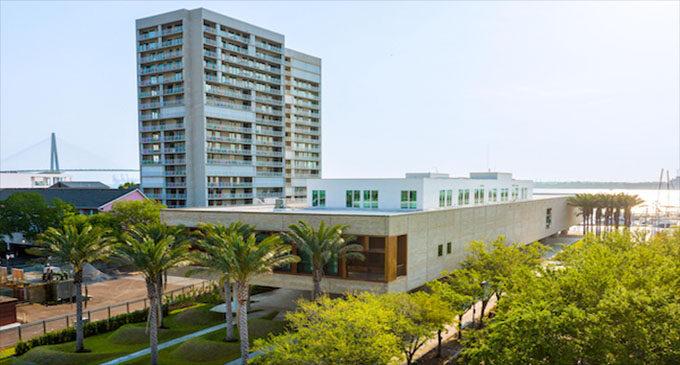International African American Museum announces opening date
Aerial view of the International African American Museum

CHARLESTON, S.C. – After over 20 years of planning, the International African American Museum (IAAM) has announced that the museum will be welcoming visitors for opening the weekend of January 21, 2023.
Built upon the former site of Gadsden’s Wharf – one of the nation’s most prolific slave trading ports – the International African American Museum will create an opportunity for visitors to engage with authentic and lesser-known history through transformative storytelling, compelling artifacts and exhibitions, and its unique “power of place.” The mission of the museum is to honor the untold story of the African American journey at one of America’s most sacred sites, and the long-awaited institution is poised to take this next step in delivering on this promise.
The museum encompasses nearly 150,000 sq. ft. of exhibition, learning, and interpretive space. Nine exhibition galleries range in theme from introducing the African origins and diasporic connections of African Americans to revealing centuries of African American economic, creative, and social contributions of American history, to taking an unvarnished look at slavery and enslaved people’s fight for human dignity. Located at the edge of Charleston Harbor with a clear view of the Atlantic Ocean, the museum’s distinctive design includes the African Ancestors Memorial Garden. The stunning “gardens within a garden” design that incorporates art installations, live plantings, and an infinity reflection pool was conceived by landscape architect Walter Hood, a 2019 MacArthur Foundation “Genius Grant” winner.
“I am proud to have worked with our incredible team to get this museum to opening day. This museum will be a must-see space of courageous curiosity and authentic engagement with our nation’s history – with African American history,” says Dr. Tonya Matthews, president and CEO of the International African American Museum. “Committed reckoning with history is a necessary stop on the road to healing and reconciliation. Charleston is a port city, a global city, a historic city – and there is no better place for our museum to steward these stories that have such national and international significance and impact.”
The museum, recently designated by Smithsonian Magazine as one of the most anticipated museum openings, was first publicly announced by former Mayor of Charleston Joseph P. Riley, Jr., during a “State of the City” address in 2000. Throughout the decades-long journey to build the museum, Riley expressed and committed to the necessity of honoring the experiences and contributions that African Americans brought and continue to bring to the country. “Our journey has been long because it took time to secure the optimal site,” the former mayor reflects. “A site that is called ‘sacred’ because it is precisely where so many enslaved Africans arrived in our country, and many died here. It took time to raise the resources, assemble the team, and plan every detail that would enhance the experience of being here. And it took time because we have been committed to excellence.”
Honoring the site is central to the museum’s story. The museum’s iconic silhouette, designed by world-renowned architect Henry Cobb, is created by eighteen 13-foot pillars that lift the structure over the exterior garden space, stretching out to the pier walk. A 245-foot steel band, inscribed with the names of regions from which enslaved people were brought, is being installed beneath the museum at the site of the original edge of Gadsden’s Wharf. As visitors cross this boundary, they will find themselves in the center of the museum’s Tide Tribute reflection pool while they watch boats and cargo ships that still travel the harbor’s waterways today.
Henry Louis Gates, Jr., Harvard professor and historian who was an early contributor to the museum’s shaping of its story, notes that “48.1% of all the African slaves who came to the United States entered this country through Charleston. So, for blackness, Black culture, the African experience, the African American experience, slavery – however you want to slice it – this is ground zero. I think it’s very important that a great city in the South be the home of a great museum celebrating the achievements, the history, and the culture of persons of African descent.” Gates, who is also known for his popular series on ancestry, Finding Your Roots, helped shape the museum’s concepts for its Center for Family History genealogy research library.
The International African American Museum’s Center for Family History, a best-in-class genealogy library connected to the world’s largest genealogy databases, is developing expertise in African American ancestry research. The museum’s first board chair, United States Congressman James E. Clyburn, a long-time advocate of the museum, appreciates the inclusion of a genealogy center, art installations, and galleries that span centuries of African and African American history and contributions. The former history teacher notes that the museum is a place to honor and celebrate African Americans as a whole – and that it is much more than a place to merely recount slavery.
“The grand opening of the International African American Museum is the culmination of over 20 years of hard work, and I am pleased to see it finally come to fruition,” said Congressman Clyburn. “I have always said that this museum ought to tell more than just the story of slavery and pay homage to the countless descendants of slavery who, in spite of their circumstances, rose to prominence and helped bring us closer to achieving this land’s promise of a ‘more perfect union.’ I am confident that this museum will help educate its visitors on America’s dark past and inspire future generations through stories of perseverance.”
In the years leading to its opening, the museum has hosted a variety of programs and created partnerships – at home and abroad. Because of the COVID-19 pandemic, recent museum programs have been virtual, creating ready pathways for cross-continental partnerships and programming.
There are many key community leaders and stakeholders who continue to support the museum’s last steps toward the long-awaited milestone of the museum’s opening in January, including Wilbur E. Johnson, managing partner of Clement Rivers, LLP, and chair of the museum’s board. “For everyone who has been involved with this project, this is both an exciting and gratifying time. The museum opening will represent a tangible expression of the commitment to fulfill this institution’s important and sacred mission,” says Johnson.
In the months leading up to the grand opening, the International African American Museum (IAAM) will release more details about opening celebrations, including speakers and various events. Community members and future visitors across the globe are encouraged to become charter members by visiting www.iaamuseum.org/members.











